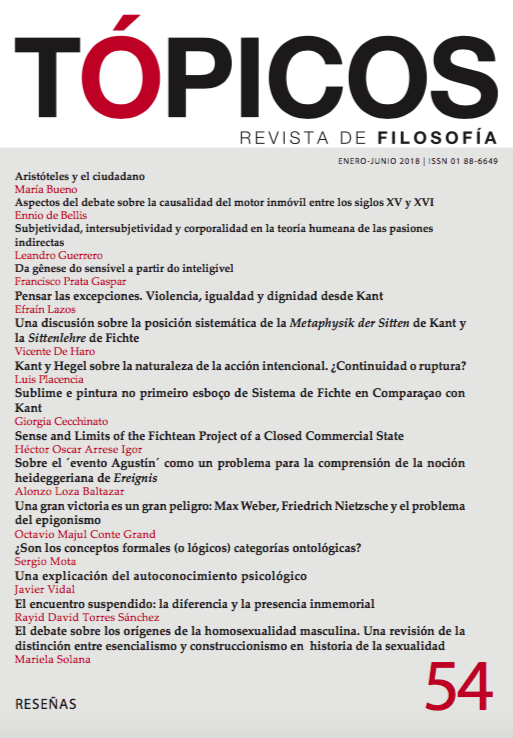Articles
Sublime and Painting in Fichte´s First Outline of System in Comparison with Kant
Published 2017-11-11
Keywords
- sublime,
- beauty,
- form,
- Kant,
- Fichte
How to Cite
Cecchinato, G. (2017). Sublime and Painting in Fichte´s First Outline of System in Comparison with Kant. Tópicos, Revista De Filosofía, 54, 201-214. https://doi.org/10.21555/top.v0i54.869
Abstract
The first aim of this paper is to present the doctrine of forms and colours in painting, formulated by Fichte in the posthumous writing Practical Philosophy. The second one is to draw a parallel between this doctrine and Kant’s theory of beauty developed in the Critique of the Judgement. On the one hand the paper will show that the similarities quite sticking, on the other hand it will reveal the peculiarity and originality of Fichte’s doctrine.References
- Cecchinato, G. (2009a). Fichte und das Problem einer Ästhetik. Würzburg: Ergon Verlag.
- Cecchinato, G. (2009b). Zeit und Farben. Die Erhabenheit der ineinander fließenden Farben. In T. Kisser (Org.) Fichres erstem Systementwurf im Vergleich zu Turners Spätwerk. (223-236).Paderborn: Fink Verlag.
- Chiereghin, F. (1991). Il problema della libertà in Kant. Trento: di Verifiche. Fichte, G. F. (2014). O destino do erudito. São Paulo: Hedra.
- Fichte, G. F. (1962-2012). Gesamtausgabe der Bayerischen Akademie der Wissenschaften. E. Fuchs, R. Lauth, H., Gliwitzky, P. Schneider. (eds.) Stuttgart-Bad Cannstadt.
- Fuchs, E. (1980). Fichte im Gespräch (Vol. 2). Stuttgart: Bad Cannstatt.
- Giordanetti, P. (1995). Kant und Winkelmann: Beobachtungen zu einer Quelle der Kritik der ästhetischen Urteilskraft. In H. Robinson. Proceedings of the Eighth International Kant Congress. (463-471). Milwaukee: Marquette University Press.
- Giordanetti, P. & Mazzocut-Mis, M. (eds.) (2005). I Luoghi del Sublime modern. Milano: Led on Line.
- Gonçalves, R. G. C. (2016). Kant, Greenberg e a questão do formalismo na arte. Salvador: EDUFBA.
- Henrich, D. (1982). Beauty and Freedom. Schiller´s Struggle with Kant´s Aesthetic. In T. Cohen & P. Guyer (eds.) Essays in Kant´s Aesthetics. (237-257). Chicago: University of Chicago Press.
- Kant, I. (1900 ss.). Kants gesammelte Schriften. hg. von der Königlich Preußischen Akademie der Wissenschaften und ihren Nachfolgern. Berlin.
- Lauth, R. (1962). Vorwort. In R. Lauth & H. Gliwitzky (eds.) Esammtausgabe der Bayerischen Akademie der Wissenschaften. (3-19). Stuttgart: Bad Cannstadt.
- Lauth, R., & Gliwitzky, H. (eds.) (1962). Esammtausgabe der Bayerischen Akademie der Wissenschaften. Stuttgart: Bad Cannstadt.
- Makkreel, R. (1984). Imagination and Temporality in Kant´s Theory of the Sublime. Journal of Aesthetics and Art Criticism, 42, 303-315.
- Mathy, D. (1989). Zur frühromantischen Selbstaufhebung des Erhabenen im Schönen. In C. Pries. Das Erhabene. Zwischen Grenzerfahrung und Größenwahn. (143-164). Weinheim: Acta Humaniora.
- Tomasi, G. (1997). Significare con le forme. Valore simbolico del bello ed espressività della pittura in Kant. Ancona: Il Lavoro Editoriale.






